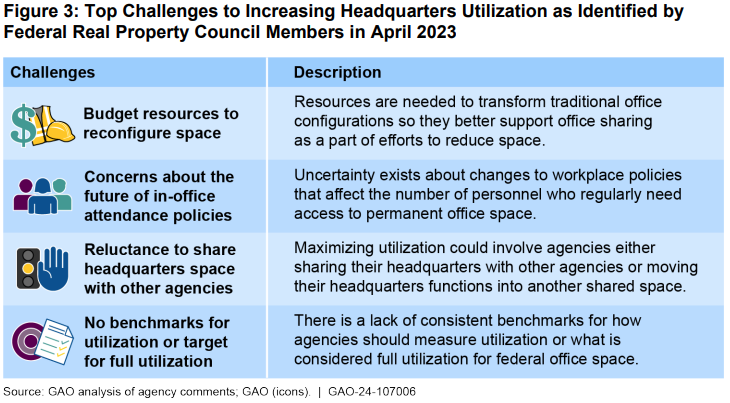A federal return-to-office won’t solve the government’s office space problems
Measuring federal office space utilization is incredibly complicated — and it has been that way for quite some time.
Last week, Arizona Republican Andy Biggs asked four agency leaders about a crucial component of the seemingly endless debate over federal telework.
“In our nation’s capital, offices are sitting empty,” Biggs said. “Do each of you know what your current building utilization rate is?”
Only one of the four agency witnesses at the House Oversight and Accountability Committee’s subcommittee hearing could answer in the affirmative. The other three didn’t have the information on hand.
But the non-answers aren’t necessarily a surprise. Measuring federal office space utilization is incredibly complicated — and it has been that way for quite some time. The Government Accountability Office has been analyzing federal office space utilization for decades.
The federal government owns over 460 million square feet of office space nationwide. And it costs billions of dollars each year to operate and maintain it.
It’s easy to point the finger at increased telework after the COVID-19 pandemic as the core reason for underutilized office space, but many GAO reports have shown otherwise.
In reality, agencies have struggled for years to figure out how much office space they need, and how to let go of what they don’t. GAO said it’s a key reason why the issue of federal real property has remained on its high-risk list for 20 years.
“Even before the pandemic shifted the balance between in-office and remote work, federal agencies struggled to identify and let go of unneeded space,” GAO said in an Oct. 26 report.

GAO creates a ratio of what it calls “building utilization” by comparing a federal building’s capacity against how much space an agency actually uses. In other words, GAO compares the total amount of usable square feet of an office building, against how many people enter that building during a workday.
David Marroni, GAO’s acting director of physical infrastructure, said telework is a reason for office space underutilization, but it’s far from the only reason. Even if an agency had 100% attendance of staff assigned to a particular building on a given day, by GAO’s calculation, it would still only be about two-thirds utilized.
Why? One big reason is simply that federal buildings are old. The way federal employees work now is vastly different than it was decades ago, which means there can be a lot of excess room that’s difficult to convert to modern uses. The Commerce Department’s headquarters office, for instance, was built in 1932 — well before employees were even using computers at work.
“They have administrative spaces, storage spaces and libraries that aren’t as relevant in modern workplaces,” Marroni told Federal News Network in July. “That takes up the usability of your space.”
At the same time, telework “certainly has driven numbers lower than they were prior to the pandemic,” Marroni said.
In a preliminary report issued earlier this year, GAO found that all 24 of the agency headquarters offices it reviewed had excess space, including 17 that had an average building capacity of just 25%.
Even agencies at the high end of that range were only using between 40% and 49% of the space at their headquarters offices.

The Commerce Department — the only agency able to answer Biggs’ question during the subcommittee hearing — is one agency in that upper range. Commerce’s headquarters occupancy increased from 24% to 42% between fiscal 2022 and now, after the department’s initial return-to-office in March 2022.
“The department anticipates that this upward trend will continue,” Jeremy Pelter, Commerce’s deputy assistant secretary for administration, said during last week’s hearing.
Even so, Commerce’s approach to telework is not one-size-fits-all. And that can complicate things.
“Many employees work in person five days a week. Department policy generally requires career employees in the Office of the Secretary to work in the office at least three days a week, with no more than two days of routine telework. Political appointees are expected to work in the office at least four days a week, with no more than one day of routine telework,” Pelter wrote in his Nov. 29 testimony to the subcommittee.
That’s the case for many agencies and it can make the measurement of office space use challenging. Agencies have employees teleworking at various levels and coming into the office on different days of the week — and even that can change week to week.
So, it’s not difficult to see why in its October report, GAO found that the Office of Management and Budget has not developed ways for agencies to measure building use that account for increases in telework.
To add to the challenges, there are no set standards for agencies to determine how much office space they really need. GSA has generally maintained a benchmark of about 180 square feet per staff member to figure out that measurement, but not every agency follows that same guideline. And the benchmark itself is being called into question. GAO officials have said that figure might not make sense anymore with now hybrid workplaces.
Still, Hank McKnelly, executive counselor to the Social Security Administration commissioner, told Oversight committee lawmakers last week that he does see a bright future when it comes to shrinking office space.
“I believe the hybrid work environment does allow us to optimize space,” he said. “And in certain cases, we can redirect those savings into serving more people.”
Nearly Useless Factoid
The Empire State Building generates more revenue from its Observation Decks than from its 85 floors of office space.
Source: ArchDaily
Copyright © 2025 Federal News Network. All rights reserved. This website is not intended for users located within the European Economic Area.
Drew Friedman is a workforce, pay and benefits reporter for Federal News Network.
Follow @dfriedmanWFED






